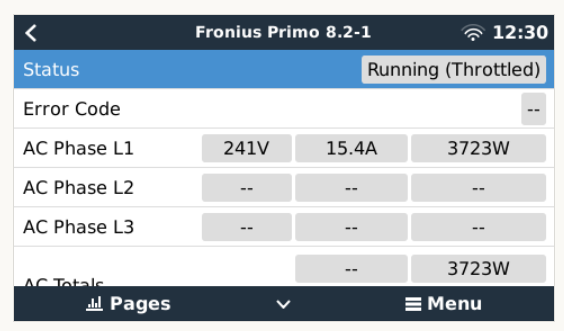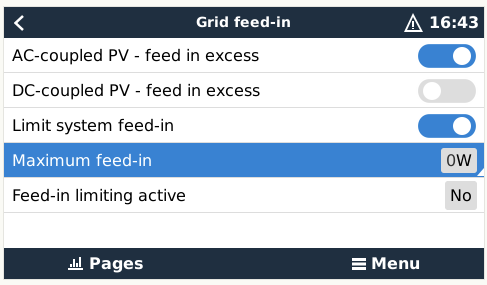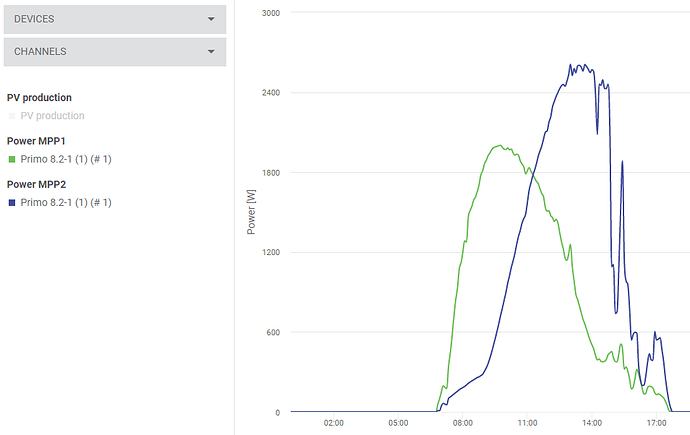Some help please… Have Victron AC coupled Fronius setup with 2 x 3.65kW east/west arrays on Fronius (no DC coupled PV). Fronius does not seem to deliver to full capacity - peak of 3.6kW at noon on full sun day which seems too low even when taking east/west into account. System is Grid limited via Victron/Fronius Modbus/TCP comms. In ESS I see Fronius status as Running (Throttled) - not sure what this means though?! On Victron Community I see thread on subject but seems issue of Fronius limited production solved in Firmware 2.65… - but what described there is what I seem to be experiencing with this setup… any thoughts?

Let me quickly explain how it works. In the ESS menu, you set a “grid setpoint”. The entire system will then aim for this value… but… that’s not the entire story. If there is a PV-inverter, and the PV-inverter is actually running (so this doesn’t happen at night), the grid setpoint is modified a little behind the scenes.
What happens is that the Multi is told to aim higher than the PV-inverter, so for example if your grid setpoint is set to 50W, then the PV-inverter aims for 50W, but the Multi aims for around 100W.
The reason for this offset is to ensure that the Multi always pulls up while the PV-inverter pushes down, so they “fight” each other and the end-effect is that if the Multi can put power into the batteries or send them to loads on the output, then it will always create that gap, and the PV-inverter will always have room to ramp up.
What we fixed in 2.65, is we made this gap bigger. Prior to that, the gap was a static 70W (or thereabouts), but for larger PV-inverters we changed it to be 2% of the total PV-inverter capacity, so that it scales with larger installations. Above 15kW, this issue (where the Fronius is limited despite there being room in the batteries) happened way more frequently, and simply making the gap larger completely solved it for those installations (one of them happens to be a hospital in Pretoria).
So this is what you need to look for. Is there somewhere that the power ought to be going? Can it? For example, a Multi derates fairly quickly when it gets hot, so you will quite often see it charging at less than you might expect. If the Multi is putting as much charge current into the battery as it is able to, or allowed to (if there is a limit), and all the loads are covered, then it is correct that the PV-inverter is limited.
But that’s not the whole story yet. Sometimes the issue is that the PV-inverter is limited while power is being taken from the grid. So far I know just one scenario where that happens, and that is where the load at the site varies considerably.
Again I need to explain what happens. The adjustment process isn’t symmetrical. A downward adjustment is always done much faster than an upwards adjustment. The PV-inverter itself is the same. If you set the limit downwards, it can hit it very rapidly, but if you tell it to ramp up, it will take a while to get there. There isn’t much that can be done about this: There are enough complaints about tripping meters already. The downwards adjustment unfortunately have to be fast (and it is technically still nowhere near fast enough).
If you then have a load that, for example, goes up and down by 200W fairly regularly, you get into a situation where the PV-inverter doesn’t have time to ramp up by 200W before it is throttled down again. And then you get into a situation where the PV-inverter is throttled while some component still comes from the grid.
So these are the things you need to look for. Which one is affecting you? Or is it something new?
Thanks @plonkster for very comprehensive response! Trying to answer as follows:
Battery does not seem to be constraining production as CCL at 160A and charging only happening at <45A. Battery temp at 21degC at the time and, although not what would cause Quattro to derate, still gives indication of environment temp. Also Quattro (8kVA) was not working hard at approx. 1.3kW. Battery SOC between 75% and 90% i.e. enough of a ‘hole’ for PV to go.
There is indeed cyclic load present but am of opinion that with space in battery PV should be pumping more… Issue is less that portion taken from grid due to down/up ramping than that in general not charging battery at high enough rate… Below the yield curves for the 2 MPPTs for the same time window…
OK, here is something to try tomorrow.
In your ESS menu, go to grid feed-in, set it like so:

Then set your ESS grid setpoint to something nice and high, like 200W. There is an exception built into the limiter, that if there is already a healthy margin between the two, it does not interfere. With settings like these, you create your own offset where the PV-inverter will aim for zero, and the Quattro will aim for 200W. You can go higher too.
The downside to this config, is that it imports 200W at night too. But for testing it will do.
If that solves the problem, then we’re dealing with the first kind of problem I referenced: Not enough space for the PV-inverter to ramp into, so it ends up in some weird equilibrium.
There is another possibility, but for this I’d have to actually inspect the modbus registers on the Fronius itself.
Model 123 (immediate controls) has a WMaxLimPct field, which is what we use to do the limiting. This is a percentage (of full power). The field has a “scale factor”, WMaxLimPct_SF in the spec, which usually allows setting the limit to the nearest 0.1%, which means the granularity is 8W for an 8kVA PV-inverter.
But if the scale factor is different, then it could make the granularity less, so that the PV-inverter can only do steps of 80W each. This is a total guess, but it is something I’ve postulated before, but I have never found a PV-inverter in the wild that couldn’t do 0.1% steps.
Of course, the larger the PV-inverter, the larger an 0.1% or 1% step becomes. 0.1% steps are small enough that it should never matter, which is why it’s never been necessary to mess with this…
Done! Will monitor tomorrow…



